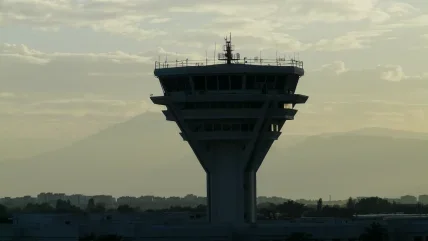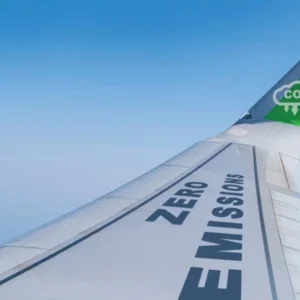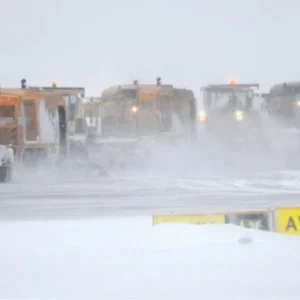
It didn’t look like much: a wooden shed on legs, with big square windows and a weathervane. It could almost have been a beach hut or an idyllic mountain chalet – if it were anywhere but Croydon. Yet it was here, on a spot now flanked by a shopping centre and a Costa Coffee drive-through, that the air traffic control tower was born. It started in 1920, when the UK’s Air Ministry unveiled Croydon Aerodrome as the place where British aviation would be run. Read through the order today and it feels wonderfully archaic. “The wireless control of all British stations,” the memo proclaims, “will be carried out by Croydon”. Officials in the tower, a full 15ft above the earth, are advised to use “telephony” to give information to incoming pilots.
Today, of course, air traffic control towers rely on far more than telephony. In Europe alone, there are 60 major control towers, run by 37 air navigation service providers, each using a sophisticated mix of technology to keep their eyes on the sky.
50m
Height of the London City Airport control tower.
London City Airport
That means satellite navigation, complex algorithms and automated tools – all of which help the EU’s air traffic management system keep over 25,000 daily flights punctual and safe. In the US, for its part, the Federal Aviation Authority (FAA) has spent a colossal $3bn on new software, something shadowed by its counterparts from Shanghai to New Delhi.
Yet for all their gadgetry, to say nothing of their tireless workload, air traffic controllers haven’t advanced as far as you might expect. Their wooden shacks have been replaced by steel and concrete towers, but many still rely on the same tools that served their predecessors in the early days of aviation: their wits, their eyes and a trusty pair of binoculars. In recent years, however, air traffic controllers have begun moving decisively away from all this – and now even their towers in the sky are at risk of extinction. And though there are certainly challenges ahead, their replacements – digital towers hundreds of miles from runways and terminals – could yet change aviation for good.
London stalling
Fly into London City Airport, and its nomenclature will announce itself like a trumpet. As you approach the runway, the Thames to your back, the umbrella of the city unfurls around you, flats and pubs and a Sainsbury’s Local all within hopping distance of the runway. The airport complex itself feels almost like an afterthought, squeezed into barely a square mile of turf. To put that into perspective, Heathrow luxuriates across nearly five times that. London City, in other words, is an incredibly cramped environment, something Andy Taylor says puts a premium on every inch of land. That’s especially true, explains NATS’s chief solutions officer for digital towers, when you add land reclamation to the equation. “The land is so valuable that it’s a fine balance between using any more of it than you need to house things like air traffic control.”
That’s precisely the problem London City faced a few years back. Its old air traffic control tower, squat like a ship’s deck, was too low to properly cover every corner of the airport, especially after it extended its taxiways. Of course, airport managers could simply have invested in a new, taller tower. But even ignoring the costs of London real estate, brick-and-mortar towers can cost up to $200m (about £149m), as was the case with Philadelphia International Airport’s new tower.
And, as Conor Mullan emphasises, this is far from a purely British problem. In Sweden, explains the managing director at Think Research, an independent air traffic management consultancy, Scandinavian Mountains Airport faced similar challenges, and was even on the verge of building what Mullan describes as an expensive “monument of the sky”.
A solution to these problems has theoretically been around for years: digital towers. Rather than building physical towers and manning them with binocular-toting staff, airports could simply place powerful cameras around their airport instead. As long as the connection is strong enough, officials could observe their patch from miles away. That sounds elegant enough – but then why have digital towers typically been shunned by airports the world over? One answer is the profession itself. Mullan says that trade unions resent new technology muscling in on their turf, something Taylor suggests reflects his own experience. As a senior air traffic control official at Gatwick until 2015, he says he and his colleagues probably didn’t “appreciate the technology” available to them.
This speaks to a wider point – the gap between the power of digital towers in theory and actually implementing change in the field. As Mullan explains, airports across Germany and Scandinavia have been aware of digital tower technology since the mid-2000s. “But,” says Mullan, “they didn’t really know how they would use it, what they would use it for, or how they would justify it.” Over the past decade or so, however, this uncertainty has gradually dissipated. One explanation could be the sharpening of the technology itself. It’s easier to appreciate the benefits of camera-led surveillance when the cameras themselves now boast HD resolution and increased storage. Another reason might be the dramas of recent years. If other white-collar workers can clearly do their work remotely, why not their cousins in air traffic control?
Eye in the sky
In some ways, London City’s updated tower looks like its traditional forebears. Like them, it soars high into the sky above the terminal and the river beyond. At 50m, in fact, the airport now boasts one of the tallest towers in the UK. But look more closely and this new tower is clearly different. Exceedingly narrow, with just enough room for maintenance ladders to snake up, this is obviously not a space for people to spend extended periods. That’s reiterated by the tower’s shape. Unlike its predecessor, City’s mast doesn’t mushroom out at the top, leaving no room for an observation deck. If you clambered all 206 steps up the mast, all you’d find is 14 cameras – each complete with special air compressors to keep out sugar dust. Tate and Lyle’s famous refinery, after all, is just down the road.
To put it another way, London City’s control tower is unmanned – but hardly unstaffed. Peering out those 14 cameras is a team of experts, sitting in an office 70 miles away. Based in the Hampshire town of Swannick, NATS staff use the new tower as their proxy, its cameras offering a 360º view of the airport and its runway. This is obviously an impressive achievement, one Taylor emphasises is down to the right kit. “We have alternate routes that are completely separated,” he explains of the three networks connecting London with Hampshire. “There are no crossing points, no common points of failure of any kind, such that were there an interruption of any kind on one of those routes, we would have a seamless continuation of the data supply via other routes.” In practice, that means a controller in Swannick might not even notice if one of the links suddenly went dead.
That may explain how the air navigation service provider’s (ANSP) remote system works, and how it abides by what Mullan describes as the “first commandment” of aircraft control – that staff must have “continuous visual observation” over a given airport. But that doesn’t really reveal what benefits City’s mast offers over traditional towers. One way of understanding is by thinking again on the tower’s unusual shape. Given real estate is so precious at the airport, having a tall, thin mast, without needing to account for anyone inside, obviously saves money. Compared with the £149m they might have been obliged to fork out for a new manned tower, London City’s mast only cost £20m.
Then there are those 14 cameras. Able to seamlessly zoom in on a specific aircraft, NATS staff no longer need to grab their binoculars every time they want a closer look. Nor do the advantages over binoculars end there. As Taylor explains, staring through a pair of enormous glasses necessarily forces the user to ignore anything in their periphery. But with a batch of screens in front of them, air traffic controllers can keep their eyes on several spots at once.
Keeping air traffic controllers physically separate from their stomping ground could offer other benefits too. In an emergency, or indeed a pandemic requiring social distancing, physical air traffic control towers often have to close. That naturally disrupts service, for instance as happened at JFK in July 2021, when a leak in the tower delayed hundreds of flights. It goes without saying that keeping staff in a windowless bunker somewhere isn’t a foolproof alternative – but it could help.
Change in the air
There are signs, too, that this new universe of digital towers could yet overwhelm their brick-and- mortar counterparts more broadly. There are indications, in fact, that this is already happening: Heathrow is actively experimenting with a digital system, while Budapest has moved there already. In 2013, for its part, the FAA ordered the closure of 149 small control towers across the US. Given the merging opportunities digital towers offer, moreover, this trend may well continue. As Mullan explains, remote air traffic controllers could plausibly attend to one aerodrome for the first half of their shift, then switch their attention for the second, all without breaking the crucial first commandment of their profession.
Of course, this raises the possibility that the unions are right, and that digital towers spell job losses for air traffic controllers everywhere. Mullan isn’t so sure. “I’m going to use the phrase ‘job changes’,” he says, emphasising that in quieter airports, air traffic controllers don’t always have much to do anyway. Taylor, for his part, is similarly optimistic. He suggests that digital towers could yet complement their glass and steel forebears, especially with the rise of new platforms that make them adaptable across different airports. “In my view, I see digital enhancement to existing physical towers in a hybrid type of deployment,” he says. “We’re working with airports and ANSPs around the world in deploying those at the moment.” Whatever happens, at any rate, it seems clear that Croydon’s pioneering monument of the sky is destined to become even more of a relic.
£149m
Potential cost of a traditional air traffic control tower.
Cato Institute
£20m
Cost of the new digital tower at London City Airport.
Reuters






